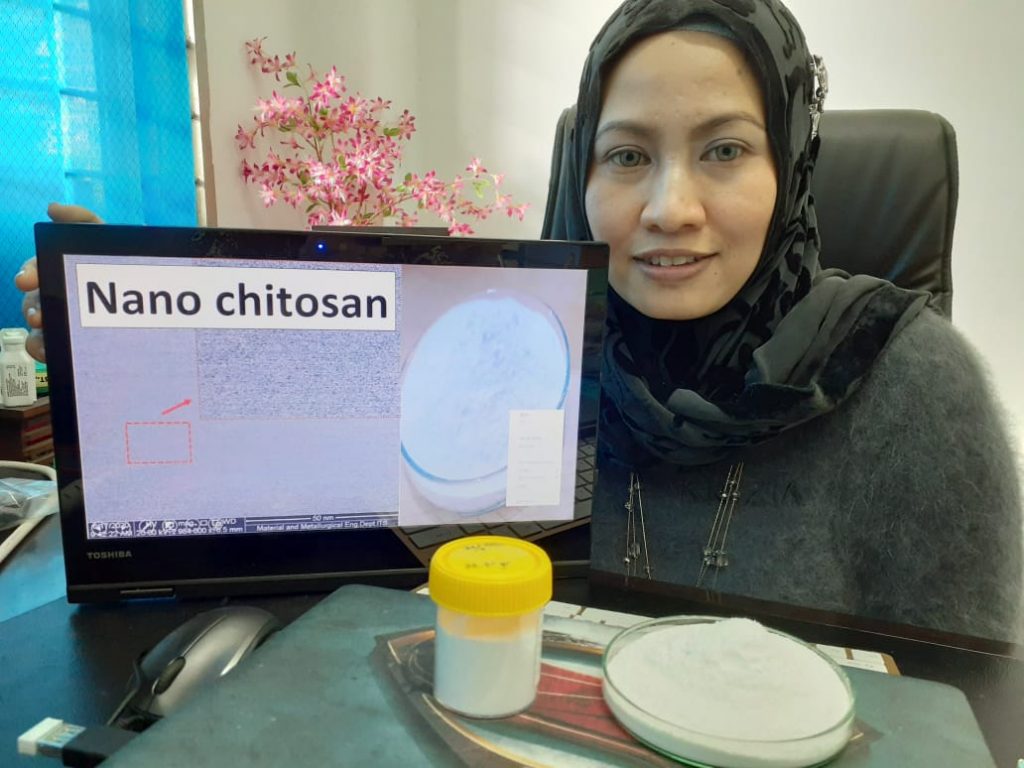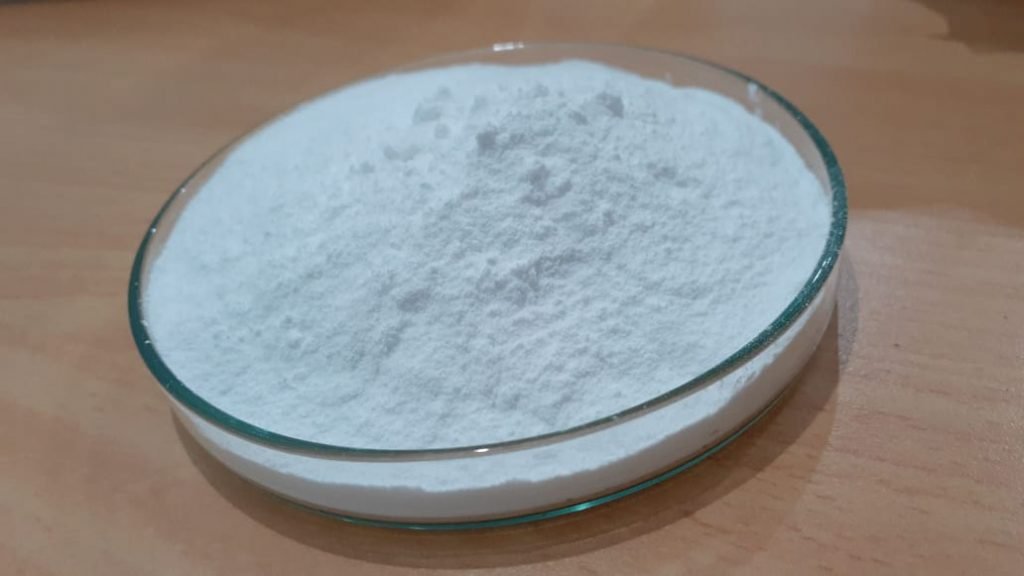ITS Lecturer Develops Nano Chitosan Research For The Treatment Of Covid-19

Yuli Setiyorini ST MPhil Ph.D. Eng showed research results of the development of Nano Chitosan that can be used for the treatment of Covid-19
ITS Campus, ITS News – the more the number of patients who are infected by the outbreak of Coronavirus Disease 2019 (Covid-19), causing many researchers around the world to research to find an efficacious treatment. No exception, one of the lecturers of Institut Teknologi Sepuluh Nopember (ITS) who also participated in conducting technology research in the form of Nano Chitosan with new methods.
Yuli Setiyorini ST MPhil Ph.D. Eng assisted by Sungging Pintowantoro ST MT Ph.D. Eng as head of Mineral and Material Processing Laboratory, Department of Material Engineering, Faculty of Industrial And Systems Engineering. Both collaborate since 2010, focused on developing chitosan as a material for medical and industrial applications with environmentally friendly methods of local raw materials.
The professor of Material and Metallurgical Engineering has explained that Chitosan is a biopolymer, a linear polysaccharide consisting of β-(1 → 4) randomly-distributed D-glucosamine (deacetylated units) and N-acetyl-D-glucosamines (acetic units). Research of the Chitosan is chitosan that does not use chemicals (green technology) by utilizing the energy of micro waves. So that the resulting product is already on a nano-scale particle (nano chitosan) and made tissue regeneration faster. “This is a chitosan product with a new process method,” she said.
Lecturers who are familiarly called Rini also explained, this new chitosan method of using shrimp and other organic waste containing chitin such as crab shells, some sea animal shells, insects as well as mushroom plants and algae as raw material. The raw material from shrimp skin was chosen because of the abundant amount of waste in Indonesia.
During this time processed waste shrimp skin is only ranged to feed livestock and a mixture of animal food pellets, therefore he chose the waste of shrimp skin to be used something useful. “If it is not processed it can trigger dangerous methane gas,” she said.
Rini said, this research started from the difficulty in obtaining chitosan products with medical quality following the research being done in Mineral and Material processing laboratory that is the development of tissue regeneration from non-biological Material to have biological properties, so it can lead to wound healing process (tissue regeneration).
According to Rini, this is the key to success in the field of biomaterials, especially the development of medical devices for replacement, one of which is an implant. “To be able to reduce the failure to use medical devices replacement in the body,” she added.
Furthermore, Rini said that the search for material that has the potential is Chitosan which has many properties for medical applications such as antibacterial, antiviral, wound healing, antiinflammation, antioxidant, biodegradable, biocompatibility, non-toxic and many more. To be known, potential traits are strongly influenced by the manufacturing process or production of chitosan itself
Although Chitosan has been widely traded in the market, continued Rini, but they don’t have the same nature or quality and performance are the same. There is a need to study the manufacturing process until it finds many shortcomings especially at the level of efficiency and environment friendly.
His research results of Chitosan product use different processes without chemicals, but by utilizing micro-waves. “With a different technique from the conventional process that uses chemical, Alhamdulillah the properties of Chitosan also different,” said the alumnus of Curtin University of Technology, Western Australia.

Physical appearance of Nano Chitosan with micro-wave process
A doctoral graduate from the Institute Materials for Research (IMR), Tohoku University, Japan is also providing chitosan that she develops not only for medical applications, but can also be applied to the food processing industry, agricultural industry, fisheries industry, textiles, paper, until rare ground metal biosorption and other heavy metals. But the main thing is to create independence in creating and producing itself from local raw materials to increase the domestic component level (TKDN) with a process that is cheap and environmentally friendly.
Her Chitosan products created with Sungging are expected to have medical quality with high efficiency, cheap and environmentally friendly. Indirectly, it answered the challenge of issues in the process of making chitosan which is currently still not efficient. Rini’s Chitosan products have some tested both in-vitro and in-vivo tests. The Chitosan has also been applied as a dental filler, bone cement, implant coating, antibacterial and therapeutic agents.
Also, Rini said, clinically testing has also been done to voluntary patients with medical trackrecord that is no longer able to be handled by doctors. And some patients do not have health insurance but the disease suffered a large cost such as cancer, diabetes, bacterial diseases, viral diseases, Covid-19 with congenital diseases (accompanying), and pneumonia and some other diseases.
For the treatment of Covid-19 patients with chitosan can reduce the replication of viruses in the body, to trigger the level of macrophage, DC (dendritic cell), and NK (natural killer cell) which plays an important role in protecting the virus infection. The rise of leukocytes along with the increase of TNF-α, IL-6, INF-ɤ, and MCP-1, can activate innate immune cells that affect the increased secretion of cytokines.
Simply known, the secretion of cytokines plays an important role as antiviral properties. Properties regeneration of Chitosan can also repair damaged tissue due to infected, where the lung tissue damage raises difficulty breathing. Plus the antiinflammation and antioxidant properties of chitosan can reduce the process of inflammation and oxidative stress during the healing process. “The selection of Chitosan as an agent due to its multi-properties, which is potentially a therapeutic agent multifunction,” she explained.
This clinical testing carried out Rini by giving chitosan therapy for free for the needy. She also wants to be able to help others in need onward, as a contribution to the knowledge that has been acquired. “Alhamdulillah, our chitosan research gives hope for these patients and the healing process is also very significant,” she said.
When mentioned about research constraints, she said that the cost of production and the formulation of health bureaucracy are the biggest obstacles. She hopes that there are partners who also have a humanitarian and social spirit for the chitosan free program for those who especially needed by the community who can not afford it.
It also confirms that its partners are not limited to academics and professionals, but are also open to industry and investors. Also, she hopes that there is a complex change in policy and bureaucracy because it greatly inhibits the development of research into the commercialization phase of the product.
Hopefully, from this research, Indonesia is no longer dependent on imported products, so independence in local raw materials that can be managed and utilized can be applied to the fulfillment of Indonesian with a more efficient and environmentally friendly process. “We hope that ITS can read the potential and prospects of the development of existing laboratories, one of which with support and support laboratory facilities at ITS both in the department and laboratories together,” said this recipient of Singapore Airlines scholarship. (bob/rev/ITS Public Relations)
Related News
-
Faithful in Times of Joy and Sorrow, Married Couple Graduate with Doctorates Together at ITS
ITS Campus, ITS News — As though guided by one heart and one soul, Dr Hanugra Aulia Sidharta ST
June 18, 2020 01:06 -
ITS Wins 2024 Project Implementation Award for Commitment to Gender Implementation
ITS Campus, ITS News —Not only technology-oriented, Institut Teknologi Sepuluh Nopember (ITS) also show its commitment to support gender
June 18, 2020 01:06 -
ITS Professor Researched the Role of Human Integration in Sustainable Architecture
ITS Campus, ITS News –The developing era has an impact on many aspects of life, including in the field
June 18, 2020 01:06 -
ITS Sends Off Group for Joint Homecoming to 64 Destination Areas
ITS Campus, ITS News — Approaching Eid al-Fitr, the Sepuluh Nopember Institute of Technology (ITS) is once again facilitating academics who want
June 18, 2020 01:06
